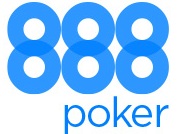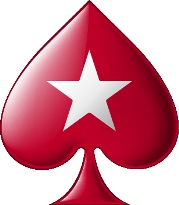If you thought the poker Omaha high-only discussion fills your brain to capacity, you’re right, it does. When you add the ability of a low hand or hands to take half the pot, the complexity of the situation simply explodes. That being said, Omaha high-low is Doug’s favorite game. It’s a fickle lover, though. When luck is on your side, this game is the sweetest, but when it’s not, it’s the most bitter. Not for the faint of heart…
With that pleasant thought in your head, let’s see what we can do with some good cards. We’ll start with the mother of all Omaha high-low hands, Ace-Ace-Deuce-Three DoubleSuited. This is strong in several ways. First, the holder has two nut flush draws. Second, they have a pair of Aces; and while it is common for a third and (less often) all four Aces to be accounted for, it does in fact mean that if an Ace does appear, it makes a possibility for the best full house (Aces full of Deuces or Threes). Playing four-handed against three random hands AA23 double-suited will win 43.3 percent of the money. So it’s a little more than twice as likely to win money. But how could the best poker starting hand only be a 2:1 favorite over three random hands, you may ask?
First, a low hand will only be possible around 50 percent of the time. Remember, in order for a low hand to qualify, there must be at least three different cards ranked Eight or lower on the board, and a player must be able to use two cards ranked Eight or lower from their hand to complete a five-card low.
TIP: A qualifying low hand only shows up about half the time in Omaha high-low.
Second, flushes don’t come regularly. True, you’ll have twice the chance with a double suited hand, but it’s still not something you can count on. In addition, there is no way for this hand to make the nut straight unless it is the wheel (a Five-high straight). This is often good for a scoop (winning the entire pot), but it’s vulnerable to redraws. For example, if someone’s in the big blind and no one raises, they get to play 6♥-7♣-8♠-9♦ for time served, er, what they’ve already put in the pot. Assume you see this flop:


 Even this flop can produce unexpected winners
Even this flop can produce unexpected winners
An Ace-Deuce now gives you both the best low hand and what is known as the ignorant straight, or a straight made with two cards from your hand connecting on the low end of the cards on the board. You may also have a backdoor flush draw if you have clubs, spades, or diamonds. If you have no flush possibilities, though, the only way you can win the high part of the pot is if you catch a combination of Aces, Deuces, and Threes to make a full house. In addition, as we’ll talk about in the next chapter, it is very possible that you may need to split the low portion of the pot with at least one other player. You will learn to hate the thought of getting quartered, which happens when you split the high or the low part of the pot with another player (a half of a half is a quarter). Twenty-five percent of the pot is certainly better than nothing, but it stinks relative to what you’re hoping for.
With the flop we just described, you know you’ll at least be getting some of the money back at the end of the hand that you initially put in the pot. A much more dicey situation comes if you have A♣-2♣-A♦-3♦, and you get this flop:


 It’s sad when a good hand goes bad.
It’s sad when a good hand goes bad.
Quite frankly, this flop is an unmitigated disaster. Your low draw is counterfeited, in that the Two and Three in your hand are now repeated on the board. The new nut low draw is AceFour, as it would make the Four-Three-Two-Ace countdown. The only way you can make a low is if two more low cards come, and then they would need to be a Four and a Five to make the nut low. We’ll talk more about the low draws on the turn, but rest assured, if you get this flop with that hand, you’ll be talking to yourself. In looking at the high part of the hand, you’re in even more trouble, as you have bottom two pair. Anyone with a Ten and other cards will almost certainly make a better two pair, and chances are a straight draw will make. A pair of Tens is especially deadly with this flop. Our simulation established that the AA23 hand will only win 8.4 percent of the money against a player with a pocket pair of Tens and two random cards and two players with completely random hands. The set of Tens wins 49.4 percent of the money, which accounts for when its set of Tens holds up as well as when some sort of straight or random low holds up. The AA23 hand is basically hoping an Ace and another Two or Three comes or that it makes a low no one else can beat. As we mentioned in the Omaha high–only discussion, it’s all about how you fit the flop. This situation is a great time to fold and curse your luck.
A much more common occurrence is for a flop to hit you pretty well but not perfectly. For instance, assume you have A♥-2♥-K♠-5♠ and you see this flop:


 This flop probably helped your opponents more than it helped you
This flop probably helped your opponents more than it helped you
The possibilities are so numerous as to border on the absurd. The only thing you do know is that you will not be making a straight flush, four of a kind, or a full house. Remember, without a pair or three to a straight flush on the flop, it is impossible to make these hands. What you do have is a bottom pair, an easily beaten low, and two possibilities to make a runner-runner flush (hearts and spades). Unless there is a lot of money in the pot, this may be a good hand to minimize your losses. First, any of several commonly played low combinations beat you. Any AceThree, Ace-Four, and Three-Four beat you as of this moment. If there are four players in the pot, it’s safe to assume at least one of them has a better low draw than you have. Because at least one of the cards you’re looking for is dead, you are not shooting for four or eight cards, but rather seven, six, or even fewer. The news doesn’t get any better on the high side of the hand. Many players will have played a pocket pair of Queens and will now have a set. A set of Eights is also a threat. It is also very possible for someone to have played a wrap-style hand containing one each of a Nine, Ten, and Jack. What this wrap straight draw does is allow for any of those three cards to give the holder a straight, with the Nine making the nut straight at that moment. You have a runner-runner draw to the nut straight, as a Ten and a Jack give you the best straight assuming no flush is made, but this is a long way to walk for the high half, no matter what possibility you consider.
On the other hand, if the flop is only slightly different, such as 3♠-8♥-Q♦, your hand is now going to be good for the low much more frequently. While not all that great as a high hand, there are still possibilities. At this point, it becomes necessary to ascertain how many players still in the hand are going for the low along with you. The easy rule of thumb when going for the low is that if there is an even number of players in the hand and a half or fewer are in competition for the low, as best you can tell, it is worth staying in. This is especially true if you have any realistic shot at the high as well. To be perfectly honest, this hand does not have much expectation to win the high side of the pot, as you need help on both the turn and the river. The low side is robust because it has the Five as a backup in case a Deuce comes on the turn or river, counterfeiting your nut low. The best thing you have going for you is that any Ace-Three is counterfeited, and now only an AceFour beats you. While very possible, the good news is that if it’s the 2♠, you now have the second-nut flush draw. We did say earlier that this game is all about showing down nut hands, but two second-nut hands aren’t as bad as it could be. Try as hard as you can to will the A♠, or especially the 4♠, to come on the river just in case, though.










